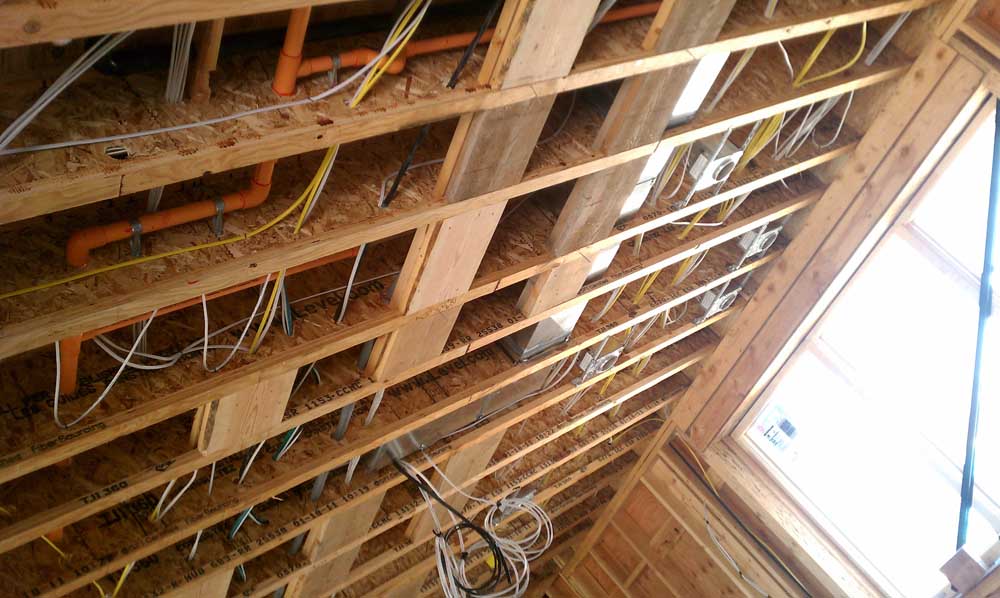Sound Planning
Published 12:00 am Saturday, March 7, 2015

- Sound Planning
We’ve all moved a couch, painted a wall, turned up the thermostat. And it’s amazing, isn’t it? Just a few small tweaks can change the look and feel of a room and entirely affect both its mood and yours. Color, texture, temperature — they’re all within the daily purview of home life.
But what about the way a room sounds — its cadence, its reverberation? What if you could affect its acoustics, its echo, to make a party better, to improve your morning puttering, and yes, to hear the crisp vocal stylings of Sam Smith with even more clarity.
Trending
With today’s sound engineers and home sound systems you can, and these days we don’t have to adapt to the technology. The technology can adapt to us, but like trying to decide what color to paint a wall, it’s our own vision of mood that’s sometimes hard to figure out.
“It’s important to find out not only what people are listening to, but how they’re consuming it,” said Jason Gillette, owner and system designer for Premier Home Systems in Bend. “And when you start asking questions, people really begin to think about the sound of their home in ways they haven’t had to before.”
“Where do you listen to music in your home?” continued Gillette. “Is it primarily background when you’re cooking dinner? Do you like to entertain? Are there two people in the house or 15? Whether you’re going to sit in a great room and soak in your favorite CD or just listen to NPR while you’re getting ready in the morning will greatly affect what kind of system best fits your home.”
“Early on it’s also important to talk about the room specifics,” said Stephen Berhar, owner of Stereo Planet in downtown Bend.
There are things that are generally standard, said Berhar, such as speaker height, which is best at ear level. It’s also best for stationary music listening, such as when you’re sitting at your couch enjoying some Rachmaninoff, to place the speakers at an equidistant ratio between each other and you. But even the science of sound can be affected by other unaccounted for factors in the room.
“They spent millions of dollars to engineer the acoustics at Lincoln Center in New York City, and they’re still nowhere near as good as the acoustics at Carnegie Hall that just happened by accident,” said Berhar. “It’s both science and art, and really the best thing to do is to be in a room and try things out.”
Trending
After you’ve considered what you’re listening to, why you’re listening to it, and even some of the details about how you want it to sound, there’s also where you’re sourcing your music from.
“We all used to have headphones and a walkman and had to carry around eight tracks, cassettes, or CDs with us,” continued Gillette, “but now it’s Pandora, iTunes and Spotify.”
We’re able to carry our entire musical library in our pockets or stream it over the Internet, but many people don’t know what that means regarding how it affects sound quality.
“An LP is still the best way to experience phenomenal recorded music,” added Gillette. “It’s fully analog, analog to analog, not converted to digital to save space. … A CD is still going to get you better quality music than streaming, and when streaming, many people don’t know that services like Pandora have two services: the free service with low quality streaming, but you can get a higher quality streaming service for a monthly fee.”
“It’s like driving a high performance sports car with the wrong tire pressure,” continued Gillette. “No matter how great a car engine or sound system is, if another part of the equation is of less quality, you’re not fully experiencing what the system is capable of.”
Still, it isn’t completely necessary to have obtrusive, aesthetically unpleasing equipment in the middle of your living room to produce great sound.
“Aesthetics versus performance is something that I think is important to talk about early on,” said Berhar. “What can we do to put a speaker in a wall, or to paint it? How can we keep things hidden and unobtrusive to your lifestyle? In-ceiling speakers are great for filling a room with sound. They have a wide dispersion pattern, but you’re going to get better stationary listening with directionally placed speakers. … Quality of speakers is measured in frequency response — (meaning) how much bass, and efficiency — which is measured in decibels. More efficient speakers require less power to get the same decibels, but most high-end speakers use more power and are usually less efficient. Still, even with all the advances in shrinking speakers, in general, you’re not going to be able to get as good of sound out of a smaller speaker than a larger one.”
“In the world of sound, you’re dealing with physics,” said Gillette, “and you can easily fall down the rabbit hole on the way to sonic nirvana.”
He suggests that people wanting to do their own acoustic research can check out Dolby Digital’s website or the website of the Home Acoustics Alliance at www.homeacoustics.net.
“Their website hasn’t been updated since 2010,” he said with a laugh, “but they certify people, and they have a lot of great information.”
“I think the mistake a lot of people make is that they have a friend that says, ‘I did this. It worked for me. That’s what you should do,’” said Gillette. “And it just doesn’t work that way. Each situation is different, and you just have to take it as it comes.”
But most surprising when talking to a number of sound engineers a recurring theme was not budget or size of the room, not the physics or technicality of decibels or speaker placement, but some esoterically emotional version of “What is it that moves you?”
Because the most important question to ask when looking into a home sound system is not “What system will make the most high quality sound?” but “Which sound do you most connect with?”
“Music is supposed to be about an experience,” said Gillette. “Musicians want to see a crowd react. That’s what we’re trying to recreate in the home. High quality sound is about truly engaging in the experience, hearing every note. … It wouldn’t be the same if people stopped painting with the color green. What if green wasn’t going to be used in paintings anymore? That’s what it’s like to miss out on the nuance of sound.”
But even with that gospel Gillette still believes it still comes down to what you like.
“I tell people when you’re happy with your system, stop. If you like it, great. It should never be a case where you come in blindly listening to what the marketing tells you. Find a system that makes you happy, and that’s the right one for you.”








